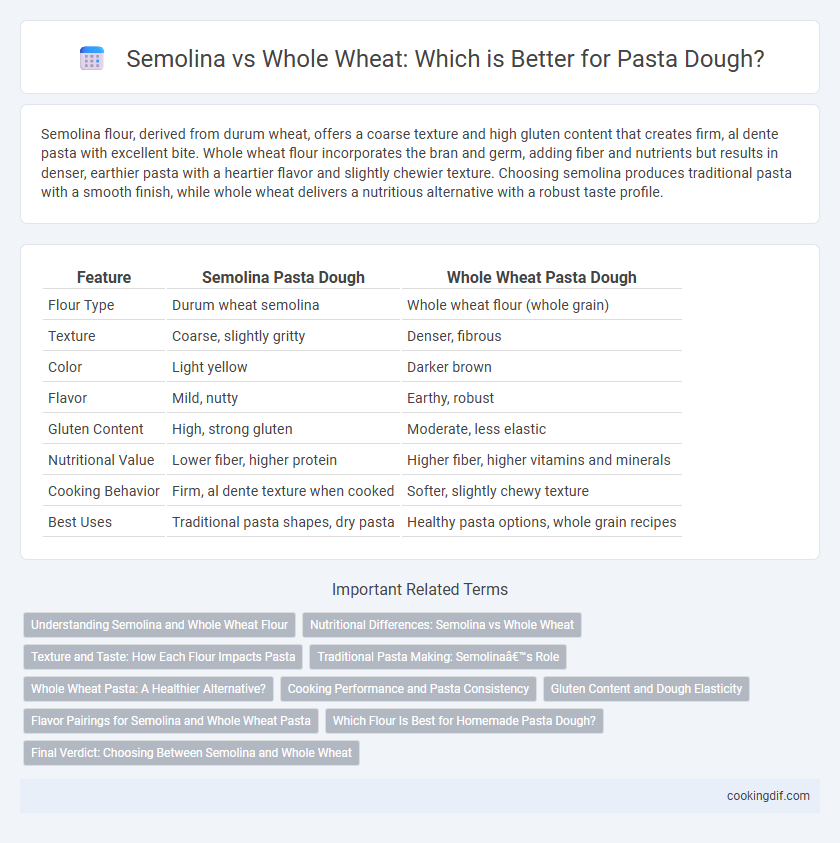Semolina flour, derived from durum wheat, offers a coarse texture and high gluten content that creates firm, al dente pasta with excellent bite. Whole wheat flour incorporates the bran and germ, adding fiber and nutrients but results in denser, earthier pasta with a heartier flavor and slightly chewier texture. Choosing semolina produces traditional pasta with a smooth finish, while whole wheat delivers a nutritious alternative with a robust taste profile.
Table of Comparison
| Feature | Semolina Pasta Dough | Whole Wheat Pasta Dough |
|---|---|---|
| Flour Type | Durum wheat semolina | Whole wheat flour (whole grain) |
| Texture | Coarse, slightly gritty | Denser, fibrous |
| Color | Light yellow | Darker brown |
| Flavor | Mild, nutty | Earthy, robust |
| Gluten Content | High, strong gluten | Moderate, less elastic |
| Nutritional Value | Lower fiber, higher protein | Higher fiber, higher vitamins and minerals |
| Cooking Behavior | Firm, al dente texture when cooked | Softer, slightly chewy texture |
| Best Uses | Traditional pasta shapes, dry pasta | Healthy pasta options, whole grain recipes |
Understanding Semolina and Whole Wheat Flour
Semolina flour, derived from durum wheat, offers a coarse texture and high gluten content ideal for traditional pasta, providing firmness and a golden hue. Whole wheat flour contains the entire grain kernel, resulting in a denser, fiber-rich dough with a nuttier flavor and darker color. Choosing between semolina and whole wheat flour impacts pasta's texture, nutritional profile, and cooking performance.
Nutritional Differences: Semolina vs Whole Wheat
Semolina pasta dough, made from durum wheat, offers higher gluten content and a firmer texture but contains fewer fibers compared to whole wheat pasta, which retains the bran and germ, boosting dietary fiber, vitamins B and E, and minerals like magnesium and zinc. Whole wheat pasta also has a lower glycemic index, promoting steadier blood sugar levels and enhanced digestive health. Choosing whole wheat over semolina increases antioxidant intake and supports heart health due to its richer nutrient profile.
Texture and Taste: How Each Flour Impacts Pasta
Semolina flour, made from durum wheat, creates pasta with a firm, slightly gritty texture and a rich, nutty flavor, ideal for holding sauces. Whole wheat flour imparts a denser, chewier texture and a robust, earthy taste due to its higher fiber content and bran presence. The choice between semolina and whole wheat flour significantly affects pasta's mouthfeel and flavor complexity, influencing culinary applications.
Traditional Pasta Making: Semolina’s Role
Semolina, derived from durum wheat, is a traditional choice for pasta dough due to its coarse texture and high protein content, which provides excellent gluten strength and elasticity. Its granular consistency absorbs water evenly, resulting in a firm, al dente texture that holds sauces well and resists overcooking. Whole wheat flour, while nutritionally richer with fiber and micronutrients, produces a denser dough that can alter the classic chew and bite characteristic of traditional semolina pasta.
Whole Wheat Pasta: A Healthier Alternative?
Whole wheat pasta contains higher fiber content and essential nutrients like vitamins B and E compared to semolina pasta, supporting better digestion and long-term health benefits. The bran and germ in whole wheat flour increase antioxidant levels and provide a lower glycemic index, making it suitable for blood sugar control. While semolina offers a traditional texture, whole wheat pasta is a nutritious alternative favored in health-conscious diets.
Cooking Performance and Pasta Consistency
Semolina pasta dough yields a firm texture and excellent cooking performance due to its high protein and gluten content, resulting in al dente pasta that holds shape without becoming mushy. Whole wheat pasta dough, containing more bran and fiber, produces a denser, grainier consistency that can affect water absorption and increase cooking time. Semolina offers superior elasticity and a smoother bite, while whole wheat pasta delivers a nuttier flavor but may have uneven cooking and a coarser mouthfeel.
Gluten Content and Dough Elasticity
Semolina flour, derived from durum wheat, contains higher gluten content than whole wheat, resulting in pasta dough with superior elasticity and firmness ideal for traditional pasta shapes. Whole wheat flour has lower gluten levels and higher bran content, which can reduce dough elasticity and create a denser, coarser texture, often requiring blending with semolina for optimal pasta quality. The gluten quality in semolina enhances water absorption and dough stretchability, enabling better shaping and cooking performance in pasta production.
Flavor Pairings for Semolina and Whole Wheat Pasta
Semolina pasta offers a slightly nutty, sweet flavor that pairs well with robust tomato-based sauces, creamy Alfredo, and seafood dishes, enhancing their richness. Whole wheat pasta brings a heartier, earthier taste that complements savory ingredients like mushrooms, garlic, herbs, and smoky meats, creating a more rustic culinary experience. Both types adapt well to different seasoning profiles, with semolina shining in lighter, delicate pairings and whole wheat excelling in bold, intense flavors.
Which Flour Is Best for Homemade Pasta Dough?
Semolina flour, with its coarse texture and high protein content, provides pasta dough with a firm bite and excellent elasticity, making it ideal for traditional Italian pasta. Whole wheat flour offers a nuttier flavor and higher fiber, but can result in denser, less pliable dough due to its bran content, which interferes with gluten development. For homemade pasta dough, semolina flour is generally preferred to achieve the perfect balance of texture and chewiness, while whole wheat is better suited for a heartier, health-focused alternative.
Final Verdict: Choosing Between Semolina and Whole Wheat
Semolina flour, derived from durum wheat, offers a coarse texture and high gluten content ideal for classic al dente pasta with firm bite and golden color. Whole wheat flour provides increased fiber, vitamins, and minerals, resulting in a denser, nuttier-flavored pasta with richer nutritional benefits. Choosing between semolina and whole wheat depends on desired texture and health goals: semolina excels in traditional pasta quality, while whole wheat supports dietary fiber intake and a more robust taste profile.
Semolina vs whole wheat for pasta dough Infographic

 cookingdif.com
cookingdif.com